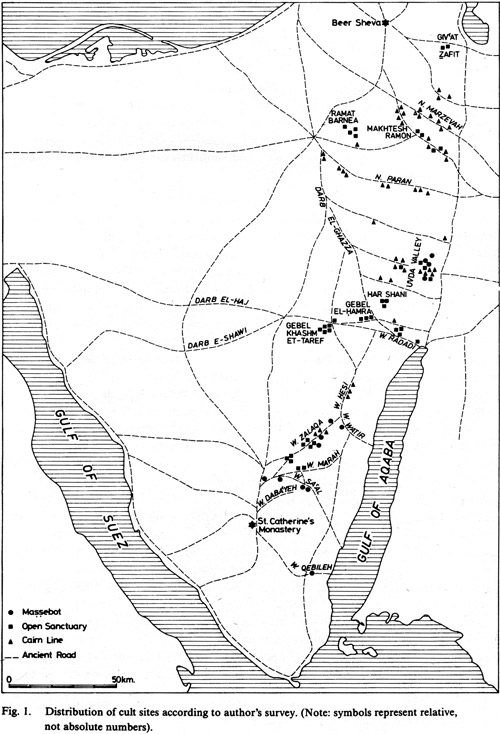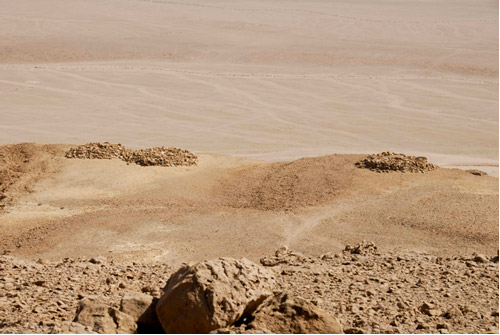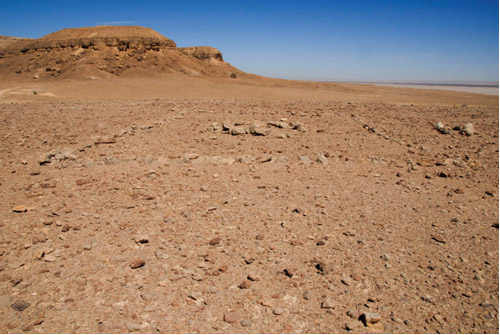The short answer to our title question is that the Mountain of God, Mt. Horeb, Mt. Sinai and Mt. Paran are all names for Mt. Sinai, and Mt. Seir is important for determining the location of Mt. Sinai. The long answer, which is the subject of this article, is that each of these names provides important clues for determining where Mt. Sinai is located. The location of Mt. Sinai is one of the major mysteries in Biblical research. Yohanan Aharoni has stated, “To-day the problem of identifying the route of the Exodus and Mount Sinai itself is one of extraordinary difficulty, far more than any other problem of Palestinian Biblical topography” (1962: 118).

Gebel Khashm et-Tarif, a mountain explored by the Associates for Biblical Research in 2007. Located ca. 22 miles west-northwest of the northern end of the Gulf of Aqaba/Elat, it is the only site thus far proposed that meets all of the Biblical requirements for Mt. Sinai.
Mt. Sinai: The Site of Important Biblical Events
Mt. Sinai occupies an important place in human history, as well as in the history of God’s people. Most significantly, it was the place where God appeared in person to Moses and gave him the law. Earlier, at the end of Moses’ 40-year exile in Midian, God appeared to him in a burning bush at the base of the Mountain of God and called him to return to Egypt to lead the Israelites to freedom (Ex 3:1–4:17). When the Israelites first arrived at Mt. Sinai, Moses struck a rock at Horeb to provide water for the multitude (Ex 17:6). They then spent 11 months at the holy mountain before breaking camp and moving on to Kadesh Barnea.
Shortly after arriving at Mt. Sinai, Jethro, Moses’ father-in-law, visited Moses and advised him on how to govern the people (Ex 18). Moses then ascended the mountain and received the law from God, as well as instructions for constructing the Tabernacle (Ex 19–31). This was followed by the sin of the golden calf and its aftermath (Ex 32–34). Skilled craftsmen among the Israelites constructed the Tabernacle and its furnishings under Moses’ supervision (Ex 35–40). The first Passover was celebrated exactly one year after leaving Egypt (Nm 9:1). Before departing, more laws were given (Lv 1–27) and a census was taken (Nm 1–10).
When the Israelites left Mt. Sinai, God’s presence went with them and the mountain no longer was a significant religious center. Mt. Sinai appeared in recorded Biblical history only one more time. Nearly six centuries after the Israelites were at Mt. Sinai, Elijah fled to “Horeb, the mountain of God” to escape the wrath of Queen Jezebel following his encounter with the priests of Baal at Mt. Carmel (1 Kgs 19:1–21). All told, some 63 chapters of the Old Testament are devoted to events that took place at Mt. Sinai. This amounts to 14 percent of the 436 historical narrative chapters from Genesis to Esther. After Elijah’s visit, Mt. Sinai dropped out of Biblical history, and its location faded from the remembrance of God’s people.

Panoramic view of the plain east of Gebel Khashm et-Tarif. The area could have accommodated many thousands of people. For scale, note the jeep in the lower right.
Mt. Horeb
The first reference to Mt. Sinai in the Bible uses the designation “Horeb” (Ex 3:1). Of the 17 times this name appears in the Old Testament, mainly in Deuteronomy, only once is it given the designation “Mt. Horeb” (Ex 33:6), otherwise it is simply “Horeb.” It is apparent from the many times the term is used in reference to events that occurred at Mt. Sinai (Ex 33:6; Dt 4:10; 5:2; 9:8; 18:16; 29:1; 1 Kgs 8:9), that Horeb is an alternative name for Mt. Sinai and not another mountain or area near Mt. Sinai.
The Mountain of God
“The mountain of God” is the name used for Mt. Sinai in the burning bush account (Ex 3:1), the meeting place of Moses and Aaron (Ex 4:27), the location where Jethro visited Moses (Ex 18:5) and Elijah’s hiding place (1 Kgs 19:8). The fact that the burning bush theophany occurred at Mt. Sinai indicates that it was within grazing distance of Midian, since Moses was “pasturing the flock of Jethro” when he met God at “Horeb, the mountain of God” (Ex 3:1). Midian was located east of the eastern arm of the Red Sea, the modern Gulf of Aqaba or Gulf of Elat. The reference to the meeting place of Moses and Aaron following Moses’ call is very important for locating Mt. Sinai.

Map of Sinai desert, according to Uzi Azner. From Tel Aviv, 11:116.
When Moses set out from Midian to return to Egypt, he would have taken the most direct route, the Trans-Sinai Highway, which traversed central Sinai from the northern end of the Gulf of Aqaba/Elat to the northern end of the western arm of the Red Sea, the Gulf of Suez. Aaron, whom God had told to meet Moses in the wilderness (Ex 4:27), would have taken the same direct route in travelling from Egypt toward Midian. Therefore, their meeting place, The Mountain of God, must have been located somewhere along this road. Furthermore, in order to be within grazing distance of Midian, it must have been near the eastern end of the road. Gebel Khashm et-Tarif, the mountain visited by an ABR team in 2007, is located in precisely this area, on the Trans-Sinai Highway ca. 22 mi west-northwest of the northern end of the Gulf of Aqaba/Elat (Wood 2007).

Burial cairns on the summit of Gebel Khashm et-Tarif indicate that the mountain was considered a holy mountain in antiquity.
Mt. Paran
Mt. Sinai is twice referred to as Mt. Paran in the Old Testament. In Moses’ blessing upon Israel prior to his death, he made a clear connection between Mt. Sinai and Mt. Paran:
The Lord came from Sinai, and dawned on them from Seir; He shown forth from Mount Paran, and He came from the midst of ten thousand holy ones; at His right hand there was flashing lightning for them (Dt 33:2; all Scripture quotations are from the NASB unless otherwise indicated).
In his closing prayer, Habakkuk made a similar connection between Mt. Sinai (implied) and Mt. Paran:
God comes from Teman, And the Holy One from Mount Paran. His splendor covers the heavens, And the earth is full of His praise. His radiance is like the sunlight; He has rays flashing from his hand. And there is the hiding of His power (3:3–4).
The name Paran most often occurs in the Old Testament as “Wilderness of Paran” (Gn 21:21; Nm 10:12; 12:16; 13:3, 26). The Wilderness of Paran was the area encompassed by the Wadi Paran and its tributaries, extending from approximately the midpoint of the Arabah Valley between the Dead Sea and the Gulf of Aqaba/Elat, southwest to the Trans-Sinai Highway. That the Trans-Sinai Highway went through the Wilderness of Paran is evident from 1 Kings 11:18. When Hadad, heir to the throne of Edom, was taken to Egypt for safety during David’s reign, his retinue followed the same route Moses took centuries earlier. Starting from Midian, they travelled to Paran then on to Egypt.
The use of Mt. Paran as an alternate name for Mt. Sinai leads to the conclusion that Mt. Sinai should be located in the Wilderness of Paran. Gebel Khashm et-Tarif is located on the Trans-Sinai highway on the southern edge of the Wilderness of Paran.

An example of one of the many stone structures found scattered around the base of Gebel Khashm et-Tarif. These stone structures suggest that a large number of people camped in the vicinity of the mountain in antiquity.
Mt. Seir
Mt. Seir is mentioned 15 times in the Old Testament and Seir 14 times. The most significant reference for our purposes is Deuteronomy 1:2: “It takes eleven days to go from Horeb to Kadesh Barnea by the Mount Seir road” (NIV). There is general agreement among scholars that Kadesh Barnea is located at Ain el-Qudeirat in northern Sinai. Most likely, the Mt. Seir road was a north-south road leading from Kadesh Barnea to Horeb/Mt. Sinai and then on to Mt. Seir. If the route of the Mt. Seir road could be ascertained, the location of Mt. Sinai could be fixed at the intersection of the Mt. Seir road with the Trans-Sinai Highway. Although Kadesh Barnea provides a northern location on the road, where was Mt. Seir, the southern terminus?
Several Biblical passages indicate that Mt. Seir was in the Wilderness of Paran in the vicinity of Mt. Sinai:
Chedorlaomer and the kings that were with him came and defeated…the Horites in their Mount Seir , as far as El-paran, which is by the wilderness (Gn 14:5–6).
Thus dwelt Esau in mount Seir (Gn 36:8, KJV). Esau took his wives from the women of Canaan…also Basemath, Ishmael’s daughter (Gn 36:2–3). He [Ishmael] lived in the wilderness of Paran (Gn 21:21).
The Lord came from Sinai, And dawned on them from Seir; He shone forth from Mount Paran (Dt 33:2).
There is a mountain named Gebel esh-Shaira 55 miles northwest of Elat which Har-El believes is the Mt. Seir of the Old Testament:
The “eleven days’ journey from Horeb by the way of Mount Seir into Kadesh-Barnea‘” (Deut. 1:20)—with Mount Seir identified as Jabal e-Seira, northwest of Eilat—also helps to locate Mount Sinai (1977: 80).
The problem with identifying this mountain as Biblical Mt. Seir is that it is too far west to be considered part of the Wilderness of Paran. But there is another mountain named Gebel esh-Shaira just six miles south-southwest of Gebel Khashm et-Tarif which is within the Wilderness of Paran. It is feasible, therefore, that the Mt. Seir Road went from Kadesh Barnea south past Gebel Khashm et-Tarif to Gebel esh-Shaira. In fact, there is an ancient track that follows that very route. If this reasoning is correct, Gebel Khashm et-Tarif would be at the intersection of the Trans-Sinai Highway and the Mt. Seir Road as required by Exodus 4:27 and Deuteronomy 1:2.

Stone-made animal figurines at the base of Gebel Khashm et-Tarif. Scholars have no explanation for this “desert art” (Avner 1984: 122). Could the figures have been made by people who had a lot of time on their hands?
The Acid Test
There is a way to test our proposed identification of Gebel Khashm et-Tarif as Mt. Sinai. If it fits the time-space conditions set forth in the wilderness itinerary preserved in the Biblical record that would add credibility to the theory. The Israelites arrived at Mt. Sinai “in the third month after the sons of Israel had gone out of the land of Egypt, on that very day” (Ex 19:1). Since they left Egypt in the first month (Nm 33:3), it took them two months, or 60 days, to reach Mt. Sinai. The travel distance from the starting point at Rameses (=Tell el-Daba) to Gebel Khashm et-Tarif is approximately 290 miles. Allowing for Sabbath rest, the Israelites would have travelled 52 of the 60 days of elapsed time. This results in an average rate of travel of 5–6 miles per day, a reasonable rate for a large group of people travelling with animals (Wood 2000).
Deuteronomy 1:2 states that it was an 11-day journey from Mt. Sinai to Kadesh Barnea. We shall assume in this case that the 11 days was the total number of travel days, rather than an elapsed time. The road distance from Gebel Khashm et-Tarif to Ain el-Qudeirat/Kadesh Barnea is about 78 miles. Traveling an average of 7 miles per day, the Israelites could have made the journey in 11 days as required by Deuteronomy 1:2.
Conclusion
The Bible provides a complex matrix of specifications for the location of Mt. Sinai. It must be toward the eastern end of the Trans-Sinai Highway and along the Mt. Seir road. In addition, Mt. Sinai should be found in the Wilderness of Paran a 60-day journey from Rameses and an 11-day journey from Kadesh Barnea. Gebel Khashm et-Tarif is the only site thus far proposed for Mt. Sinai that meets all of these requirements.
Recommended Resource for Further Study

Biblical archaeologists have gathered archaeologist data with painstaking effort and scholarship. Their work validates the accuracy of the Bible. Yet mostly within a single decade, Ron Wyatt sought out and claimed the most amazing Biblical sites and relics. The sensational discoveries claimed by Wyatt number nearly 100 and include such things as the Ark of the Covenant, anchor stones from Noah's Ark, a book of the law written by Moses, and the original Ten Commandments in stone. Also Christ's literal living blood, fences from Noah's farm, the Golden Censer, Goliath's sword, the graves of Korah and friends, the Table of Showbread, and the wheels of Pharaoh's chariots (Standish, pages 7-10). These are only the beginning. It is unfortunate for those who love the Bible that all of these incredible claims are almost certainly fraudulent. A great criticism leveled at Mr. Wyatt has been that his "evidence" has generally been in the form of either photographs or nonconclusive specimens, which may or may not have come from the source he claims. His "findings" have not been given independent confirmation by other researchers with specialized training in the fields of archaeology and related sciences, which Mr. Wyatt (a nurse anesthetist by profession) did not have (he died in 1999). This lack of specific education by itself would not invalidate his findings if they could be supported by others, but they cannot. In this book, the Standish brothers examine the Wyatt claims in-depth, going beyond his videotaped claims. These findings can serve as a benchmark upon which Ron Wyatt's "discoveries" can be more carefully evaluated. In 58 easily-read chapters the Standishs meticulously, painstakingly examine in detail all of Wyatt's claims.
Bibliography
Aharoni, Yohanan
1962 Kadesh-Barnea and Mount Sinai. Pp. 115–82 in God’s Wilderness, by Beno Rothenberg, Yohanan Aharoni and Avia Hashimshoni, trans. from Hebrew by Joseph Witriol. New York: Thomas Nelson & Sons.
Avner, Uzi
1984 Ancient Cult Sites in the Negev and Sinai Deserts. Tel Aviv 11: 115–31.
Har-El, Menashe
1977 The Exodus Route in the Light of Historical-Geographical Research. Ariel 44: 69–84.
Wood, Bryant G.
2000 Beneath the Surface: An Editorial Comment. Bible and Spade 13: 98–99, available at: http://www.biblearchaeology.org/post/2006/05/Thoughts-on-Jebel-al-Lawz-as-the-Location-of-Mount-Sinai.aspx.
2007 In Search of Mt. Sinai. Associates for Biblical Research Electronic Newsletter 7.6: 1–3.